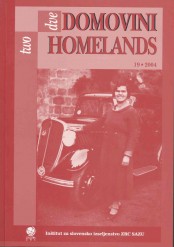The Necessity of a New Multicultural Peace Culture
Abstract
In view of the fact that the conflict of cultures has become one of the most prominent risk factors for the sustainability and future development of human civilization, its dangerous implications are examined and ways to curb it and to replace it with an ethical and peaceful multicultural system are suggested. The new regional and global multicultural system would include ethical and peace values from various cultures, and it would be based on the best of peace heritage, cultures and literature from various civilizations. It could be spread and promoted by telecommunications and the media, to counteract the regional and global culture of terror and violence. The establishment of an open global multicultural system and media, can help to impart to humanity a new multicultural identity, in addition to national and ethnic cultures and identities, and it can guide humankind in making the world more secure. The development of multicultural peace satellites over conflicted areas, which would spread the best of what is available in neighboring cultures and civilizations at the regional and global levels, would help to promote a peace climate. It would create bridges of understanding between people and nations and would abate the fear of the "other". Peace Museums are suggested toward creating multiculturalism. Israeli and Palestinian multiculturalism in Haifa is examined, and a Case Study of IFLAC-The Bridge organization is described and analyzed, as a model of multicultural coexistence.
There is likewise a necessity for a new revolution of “objectivity” in the media. Communications and the media should be brought to regard “Multicultural News and Peace News” as “newsworthy,” and a balance should be achieved between the reporting of “good news”, and not mostly, as is now the case, the covering of sensational reporting of violence and crime. The disproportional amount of homicidal and crime films and news, inflate the negative aspects of society and are a deformation of reality and normalcy. An innovative multicultural educational and cultural system, built on the peace heritage, literature and art from the various nations of the earth, and promoted by the media and advanced technology communications, is required at all levels of education including that of teachers and parents, in order to inculcate new multicultural, pluralistic and ethical peace values at all socio-levels, and to usher the promotion of a global village beyond war. If an influential regional and global multicultural system begins to sprout, the seeds for true peace would be duly planted, and it would indeed give a fair chance for the many "Voices and Cultures of the Earth" and their great yearning for global sustainability and peace, to be heard.
Downloads
References
Aharoni, A., et al., ed. A Song to Life and to World Peace: Selected essays and poems presented at the XIII World Congress of Poets of the World Academy of Arts and Culture. Jerusalem: Posner and Sans, 1993.
— . Peace Flower: A Space Adventure: A Quest fo r World Peace fo r young and old. Haifa: M. Lachm an, 1995.
— , ed. Galim-Waves C uture o f Peace Anthology, Numbers I to 10; (Galim Number 8: Waves o f Peace, In M emoiy o f Yitzhak Rabin, Selected essays and poem s; New Waves 2000, a n d 2003: Peace C uture Anthology, Galim-Waves 9 and 10, include essays by A lbert Einstein, Shimon Peres, K ofi A nnan, Saul Bellow, and selected articles, poems, pictures and paintings.) Jerusalem: (IFLAC) Jerusalem Books, 1987-2003.
— . N ot In Vain: An Extraordinary Life, and The TheO/y o f Peace Culture. CA: Ladybug Press, 1998. (An e-book and CD are also available from am azon.com in conjunction with Rowe Publishing, England.)
— . From the Nile to the Jordan. Jerusalem: Jerusalem Books (jerbooks@ netmedia. co.il, am azon.com ), 1999.
— , cd. Horizon: Pave Peace, Peace Culture Online Magazine, nos. 1-5, 1996-1999. (N um ber 4 is dedicated to “ Women, Children and P eace” ) www.New-Horizon. up.co.il
— . Peacemaking Through Culture: A N ew Approach to the A rablPalestinian-lsraeli Conflict. ln: Peace Studies from a Global Perspective: Human Needs in a Cooperative World, ed. Ursula Oswald Spring. Delhi: M aadhyam Book Services, 2000, pp. 252-280.
— . You a n d / Can Change the World. Haifa: M icha Lachmann, 2000 (amazon.com; includes Poems from Israel, International Peace Poetry, Letter to An A rab Friend, and pictures o fIsraelis and Palestinians together in Gaza).
Downloads
Published
How to Cite
Issue
Section
License

This work is licensed under a Creative Commons Attribution-NonCommercial-NoDerivatives 4.0 International License.
Authors guarantee that the work is their own original creation and does not infringe any statutory or common-law copyright or any proprietary right of any third party. In case of claims by third parties, authors commit their self to defend the interests of the publisher, and shall cover any potential costs.
More in: Submission chapter





